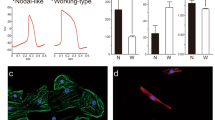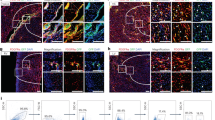Abstract
Recent studies have suggested that bone marrow cells might possess a much broader differentiation potential than previously appreciated. In most cases, the reported efficiency of such plasticity has been rather low and, at least in some instances, is a consequence of cell fusion. After myocardial infarction, however, bone marrow cells have been suggested to extensively regenerate cardiomyocytes through transdifferentiation. Although bone marrow–derived cells are already being used in clinical trials, the exact identity, longevity and fate of these cells in infarcted myocardium have yet to be investigated in detail. Here we use various approaches to induce acute myocardial injury and deliver transgenically marked bone marrow cells to the injured myocardium. We show that unfractionated bone marrow cells and a purified population of hematopoietic stem and progenitor cells efficiently engraft within the infarcted myocardium. Engraftment was transient, however, and hematopoietic in nature. In contrast, bone marrow–derived cardiomyocytes were observed outside the infarcted myocardium at a low frequency and were derived exclusively through cell fusion.
This is a preview of subscription content, access via your institution
Access options
Subscribe to this journal
Receive 12 print issues and online access
$209.00 per year
only $17.42 per issue
Buy this article
- Purchase on Springer Link
- Instant access to full article PDF
Prices may be subject to local taxes which are calculated during checkout





Similar content being viewed by others
References
Lagasse, E., Shizuru, J.A., Uchida, N., Tsukamoto, A. & Weissman, I.L. Toward regenerative medicine. Immunity 14, 425–436 (2001).
Gussoni, E. et al. Dystrophin expression in the mdx mouse restored by stem cell transplantation. Nature 401, 390–394 (1999).
Petersen, B.E. et al. Bone marrow as a potential source of hepatic oval cells. Science 284, 1168–1170 (1999).
Mezey, E., Chandross, K.J., Harta, G., Maki, R.A. & McKercher, S.R. Turning blood into brain: cells bearing neuronal antigens generated in vivo from bone marrow. Science 290, 1779–1782 (2000).
Brazelton, T.R., Rossi, F.M., Keshet, G.I. & Blau, H.M. From marrow to brain: expression of neuronal phenotypes in adult mice. Science 290, 1775–1779 (2000).
Lagasse, E. et al. Purified hematopoietic stem cells can differentiate into hepatocytes in vivo . Nat. Med. 6, 1229–1234 (2000).
Orlic, D. et al. Bone marrow cells regenerate infarcted myocardium. Nature 410, 701–705 (2001).
Jackson, K.A. et al. Regeneration of ischemic cardiac muscle and vascular endothelium by adult stem cells. J. Clin. Invest. 107, 1395–1402 (2001).
Kawada, H. & Ogawa, M. Bone marrow origin of hematopoietic progenitors and stem cells in murine muscle. Blood 98, 2008–2013 (2001).
Wagers, A.J., Sherwood, R.I., Christensen, J.L. & Weissman, I.L. Little evidence for developmental plasticity of adult hematopoietic stem cells. Science 297, 2256–2259 (2002).
Castro, R.F. et al. Failure of bone marrow cells to transdifferentiate into neural cells in vivo . Science 297, 1299 (2002).
McKinney-Freeman, S.L. et al. Muscle-derived hematopoietic stem cells are hematopoietic in origin. Proc. Natl. Acad. Sci. USA 99, 1341–1346 (2002).
Geiger, H. et al. Analysis of the hematopoietic potential of muscle-derived cells in mice. Blood 100, 721–723 (2002).
Ying, Q.L., Nichols, J., Evans, E.P. & Smith, A.G. Changing potency by spontaneous fusion. Nature 416, 545–548 (2002).
Terada, N. et al. Bone marrow cells adopt the phenotype of other cells by spontaneous cell fusion. Nature 416, 542–545 (2002).
Wang, X. et al. Cell fusion is the principal source of bone-marrow-derived hepatocytes. Nature 422, 897–901 (2003).
Vassilopoulos, G., Wang, P.R. & Russell, D.W. Transplanted bone marrow regenerates liver by cell fusion. Nature 422, 901–904 (2003).
Alvarez-Dolado, M. et al. Fusion of bone-marrow-derived cells with Purkinje neurons, cardiomyocytes and hepatocytes. Nature 425, 968–973 (2003).
Priller, J. et al. Neogenesis of cerebellar Purkinje neurons from gene-marked bone marrow cells in vivo . J. Cell Biol. 155, 733–738 (2001).
Krause, D.S. et al. Multi-organ, multi-lineage engraftment by a single bone marrow-derived stem cell. Cell 105, 369–377 (2001).
Wang, X. et al. Kinetics of liver repopulation after bone marrow transplantation. Am. J. Pathol. 161, 565–574 (2002).
Quaini, F. et al. Chimerism of the transplanted heart. N. Engl. J. Med. 346, 5–15 (2002).
Laflamme, M.A., Myerson, D., Saffitz, J.E. & Murry, C.E. Evidence for cardiomyocyte repopulation by extracardiac progenitors in transplanted human hearts. Circ. Res. 90, 634–640 (2002).
LaBarge, M.A. & Blau, H.M. Biological progression from adult bone marrow to mononucleate muscle stem cell to multinucleate muscle fiber in response to injury. Cell 111, 589–601 (2002).
Ianus, A., Holz, G.G., Theise, N.D. & Hussain, M.A. In vivo derivation of glucose-competent pancreatic endocrine cells from bone marrow without evidence of cell fusion. J. Clin. Invest. 111, 843–850 (2003).
Orlic, D. et al. Mobilized bone marrow cells repair the infarcted heart, improving function and survival. Proc. Natl. Acad. Sci. USA 98, 10344–10349 (2001).
Strauer, B.E. et al. Repair of infarcted myocardium by autologous intracoronary mononuclear bone marrow cell transplantation in humans. Circulation 106, 1913–1918 (2002).
Assmus, B. et al. Transplantation of progenitor cells and regeneration enhancement in acute myocardial infarction (TOPCARE-AMI). Circulation 106, 3009–3017 (2002).
Stamm, C. et al. Autologous bone-marrow stem-cell transplantation for myocardial regeneration. Lancet 361, 45–46 (2003).
Wright, D.E., Wagers, A.J., Gulati, A.P., Johnson, F.L. & Weissman, I.L. Physiological migration of hematopoietic stem and progenitor cells. Science 294, 1933–1936 (2001).
Bryder, D. & Jacobsen, S.E. Interleukin-3 supports expansion of long-term multilineage repopulating activity after multiple stem cell divisions in vitro . Blood 96, 1748–1755 (2000).
Okabe, M., Ikawa, M., Kominami, K., Nakanishi, T. & Nishimune, Y. 'Green mice' as a source of ubiquitous green cells. FEBS Lett. 407, 313–319 (1997).
Osawa, M., Hanada, K., Hamada, H. & Nakauchi, H. Long-term lymphohematopoietic reconstitution by a single CD34lo/neg hematopoietic stem cell. Science 273, 242–245 (1996).
Kronenwett, R., Martin, S. & Haas, R. The role of cytokines and adhesion molecules for mobilization of peripheral blood stem cells. Stem Cells 18, 320–330 (2000).
Bensinger, W.I. & Storb, R. Allogenic peripheral blood stem cell transplantation. Rev. Clin. Exp. Hematol. 5, 67–86 (2001).
Zambrowicz, B.P. et al. Disruption of overlapping transcripts in the ROSA beta geo 26 gene trap strain leads to widespread expression of β-galactosidase in mouse embryos and hematopoietic cells. Proc. Natl. Acad. Sci. USA 94, 3789–3794 (1997).
Fleischmann, M. et al. Cardiac specific expression of the green fluorescent protein during early murine embryonic development. FEBS Lett. 440, 370–376 (1998).
Roell, W. et al. Cellular cardiomyoplasty improves survival after myocardial injury. Circulation 105, 2435–2441 (2002).
Agbulut, O. et al. Temporal patterns of bone marrow cell differentiation following transplantation in doxorubicin-induced cardiomyopathy. Cardiovasc. Res. 58, 451–459 (2003).
Oh, H. et al. Cardiac progenitor cells from adult myocardium: homing, differentiation, and fusion after infarction. Proc. Natl. Acad. Sci. USA 100, 12313–12318 (2003).
Kang, H.-J. et al. Effects of intracoronary infusion of peripheral blood stem-cells mobilised with granulocyte-colony stimulating factor on left ventricular systolic function and restenosis after coronary stenting in myocardial infarction: the MAGIC cell randomised clinical trial. Lancet 363, 751–756 (2004).
Matsubara, H. Risk to the coronary arteries of intracoronary stem cell infusion and G-CSF cytokine therapy. Lancet 363, 746–747 (2004).
Shintani, S. et al. Mobilization of endothelial progenitor cells in patients with acute myocardial infarction. Circulation 103, 2776–2779 (2001).
Balsam, L.B. et al. Haematopoietic stem cells adopt mature haematopoietic fates in ischaemic myocardium. Nature 428, 664–668 (2004).
Murry, C.E. et al. Haematopoietic stem cells do not transdifferentiate into cardiac myocytes in myocardial infarcts. Nature 428, 668–673 (2004).
Roell, W. et al. Cellular cardiomyoplasty in a transgenic mouse model. Transplantation 73, 462–465 (2002).
Borge, O.J., Adolfsson, J. & Jacobsen, A.M. Lymphoid-restricted development from multipotent candidate murine stem cells: distinct and complimentary functions of the c-kit and flt3- ligands. Blood 94, 3781–3790 (1999).
Acknowledgements
We thank A. Björklund for fruitful discussions and expert advice on confocal microscopy data; L. Wittman, E. Chodkiewicz, Y. Duan and Z. Wu for expert technical assistance; and the FACS Facility at Lund Strategic Research Center for Stem Cell Biology and Cell Therapy for assistance with cell sorting. This work was supported by the Swedish Heart Lung Foundation, the Juvenile Diabetes Research Foundation, the Swedish Diabetes Foundation, the Swedish Research Council, the Deutsche Forschungsgemeinschaft (FL 276/4-2) and the scientific exchange program North Rhine Westphalia-Sweden. The Lund Stem Cell Center is supported by a Center of Excellence grant in life sciences from the Swedish Foundation for Strategic Research.
Author information
Authors and Affiliations
Corresponding author
Ethics declarations
Competing interests
The authors declare no competing financial interests.
Rights and permissions
About this article
Cite this article
Nygren, J., Jovinge, S., Breitbach, M. et al. Bone marrow–derived hematopoietic cells generate cardiomyocytes at a low frequency through cell fusion, but not transdifferentiation. Nat Med 10, 494–501 (2004). https://doi.org/10.1038/nm1040
Received:
Accepted:
Published:
Issue Date:
DOI: https://doi.org/10.1038/nm1040
This article is cited by
-
Cell fusion upregulates PD-L1 expression for evasion from immunosurveillance
Cancer Gene Therapy (2024)
-
Paracrine Factors Released by Stem Cells of Mesenchymal Origin and their Effects in Cardiovascular Disease: A Systematic Review of Pre-clinical Studies
Stem Cell Reviews and Reports (2022)
-
Modified Exosomes: a Good Transporter for miRNAs within Stem Cells to Treat Ischemic Heart Disease
Journal of Cardiovascular Translational Research (2022)
-
Stem Cells and the Microenvironment: Reciprocity with Asymmetry in Regenerative Medicine
Acta Biotheoretica (2022)
-
Intercellular mitochondrial transfer as a means of tissue revitalization
Signal Transduction and Targeted Therapy (2021)



